The Fifties and Nineteen Sixties marked the rise of laptop science. IT was throughout these many years that laptop science and its related fields began to progress at a speedy tempo. This progress necessitated the usage of a structured method to software program improvement, thus giving rise to software program improvement life cycle (SDLC) methodologies. Over the previous three-quarters of a century, software program improvement has advanced as new approaches and strategies changed outdated ones.
On this article, we are going to focus on the highest 10 SDLC methodologies in 2024. Nonetheless, earlier than we focus on these approaches, IT is sweet to make clear the fundamentals and the historic evolution of software program improvement.
Let’s begin with a definition of software program improvement life cycle methodologies in software program improvement companies.
What are Software program Growth Life Cycle Methodologies?
Software program Growth Life Cycle (SDLC) methodologies are structured approaches or frameworks used to information the method of growing software program from conception to deployment and upkeep. These methodologies present a scientific solution to plan, design, construct, check, and deploy software program techniques.
There are a number of SDLC methodologies, every with its personal set of rules, practices, and processes. We’ll focus on the ten greatest SDLC methodologies under. Nonetheless, we are going to first give a historic overview of how software program improvement methodologies advanced.
Historic Evolution of SDLC Methodologies
We should spotlight how conventional software program improvement approaches like Waterfall reworked into Agile SDLC. Let’s speak concerning the Waterfall method.
Waterfall – The Conventional Software program Growth Mannequin
The Waterfall mannequin, though out of date now, stands as a important milestone within the historical past of software program methodologies. IT laid the groundwork for all future approaches to software program improvement, like Agile. The idea of a linear, sequential course of for software program improvement gained traction within the burgeoning subject of computing through the Nineteen Seventies.
In 1970, an American laptop scientist named Winston W. Royce penned a seminal paper, “Managing the Growth of Massive Software program Techniques.” This paper outlined a structured method to software program improvement. IT proposed a sequence of sequential phases, together with necessities evaluation, system design, implementation, testing, deployment, and upkeep, the place every section flowed downstream into the subsequent, similar to a waterfall – and therefore, its title.
Regardless of its conceptual simplicity and preliminary recognition, the Waterfall mannequin quickly encountered sensible challenges in real-world software program initiatives. Its inherent rigidity and assumption of predictability within the improvement course of usually led to difficulties in accommodating adjustments, evolving necessities, and adapting to shifting priorities.
Furthermore, the mannequin’s linear nature meant that suggestions loops between stakeholders and builders had been restricted. This brought on mismatches between the ultimate product and person expectations.
Regardless of its shortcomings, Royce’s Waterfall mannequin remained a well-liked method to software program improvement within the Eighties and ‘90s, particularly in domains comparable to aerospace, protection, and large-scale authorities initiatives, the place corporations had to make sure strict adherence to predefined specs and laws.
However very quickly, within the late Nineteen Nineties, the software program improvement business started to maneuver past this mannequin as their practices matured and initiatives grew to become more and more complicated. Builders and organizations started to acknowledge the necessity for extra versatile, adaptive methodologies that would higher accommodate altering necessities, mitigate dangers, and ship worth incrementally. This finally gave rise to a set of practices and approaches collectively known as the Agile software program improvement approaches.
Let’s focus on these now.
Prime 10 SDLC Methodologies
The constraints of the Waterfall mannequin in the end spurred the evolution towards extra agile and adaptable approaches. This resulted in a major shift in how software program is conceptualized, developed, and delivered. Nonetheless, a few of these approaches are not actively utilized by builders however nonetheless advantage point out.
Let’s focus on a few of these prime SDLC methodologies now.
-
The Prototyping Mannequin
One of many earliest substitutes for the Waterfall mannequin was the Prototyping method. IT emphasised the event of low-fidelity prototypes to collect person suggestions, which, in flip, was used to develop the prototypes additional in direction of the ultimate software program product. Builders not use this method, which was developed someplace within the Nineteen Seventies.
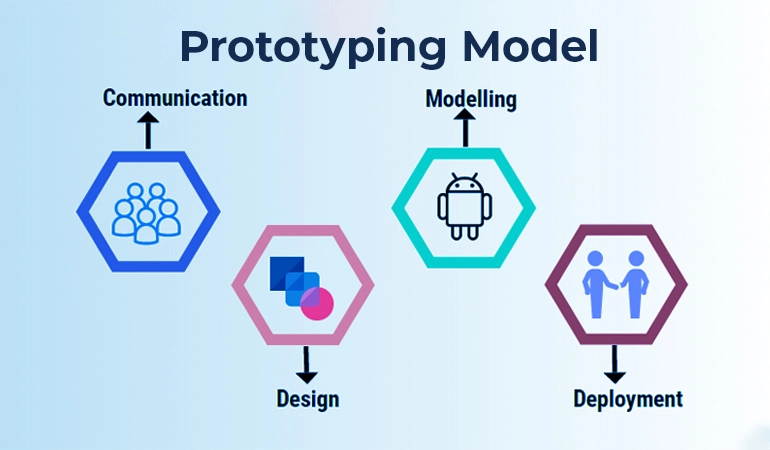

Nonetheless, the good thing about this mannequin was that IT helped in conditions the place the challenge necessities weren’t articulated, as IT allowed potential customers to work together with a tangible prototype early within the improvement course of.
-
The Iterative Mannequin
The Iterative mannequin is an early forerunner of the Agile method. IT includes repeating the event course of in a sequence of iterations or increments. Every iteration encompasses all of the SDLC levels, together with necessities gathering, design, implementation, testing, and deployment.
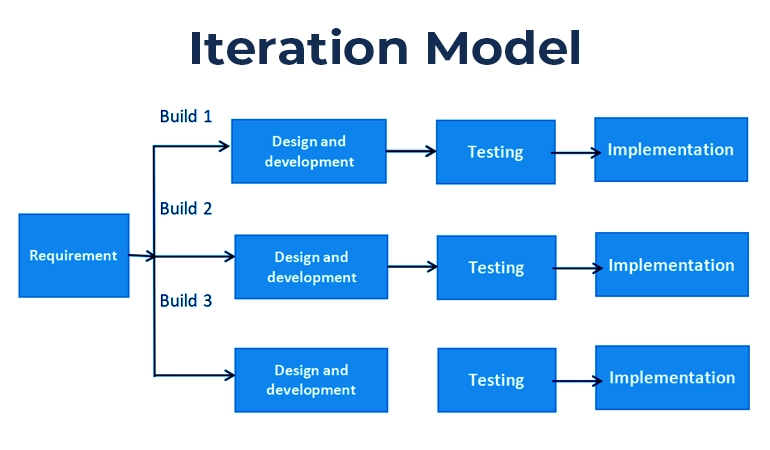

Not like the linear development of the Waterfall mannequin, the Iterative mannequin permits for flexibility and adaptation all through the event cycle. In every iteration, the software program developer selects a subset of options for implementation primarily based on precedence and stakeholder suggestions. The software program is then developed, examined, and delivered in a brief timeframe, usually starting from a couple of weeks to a few months.
On the finish of every iteration, the builders consider the software program and incorporate the suggestions in subsequent iterations. This iterative course of continues till the software program meets the specified stage of high quality and performance.
-
The Spiral Mannequin
The Spiral mannequin is the brainchild of Barry Boehm. He wrote a paper in 1986 titled “A Spiral Mannequin of Customized Software program Growth and Enhancement,” which defined this method. The Spiral mannequin integrates parts of iterative improvement with threat administration rules and, just like the Iterative method, IT sought to beat Waterfall’s limitations.


The Spiral mannequin emphasizes threat administration all through the event course of, with every iteration permitting for the identification and mitigation of dangers early on. IT is especially well-suited for big, complicated initiatives the place necessities are unclear or topic to vary. Nonetheless, its iterative nature also can improve its improvement time and value.
-
V-Mannequin
The V-shaped mannequin can also be known as the Verification and Validation Mannequin – IT is a variant of the normal Waterfall mannequin and emphasizes the connection between every section of improvement and its corresponding testing section.
IT can also be named as such for its V-shaped illustration of the event and testing phases. The left aspect of the V represents the event phases, whereas the appropriate aspect represents the corresponding testing phases.


This method helps builders be certain that defects are recognized and addressed early within the improvement course of, thus minimizing the chance of expensive rework in a while. Nonetheless, like the normal Waterfall Mannequin, the V-shaped mannequin is taken into account inflexible and fewer adaptable to adjustments in necessities or stakeholder suggestions.
-
Agile
The world of software program improvement underwent a revolution when 17 prime software program specialists determined to draft the Agile Manifesto in 2001. The Agile Software program Growth Lifecycle emphasizes iterative improvement, collaboration, adaptability, and buyer satisfaction. IT is taken into account the foremost SDLC method in use right this moment. Many Agile frameworks took root due to this method, together with Kanban and Scrum, which we are going to focus on shortly.
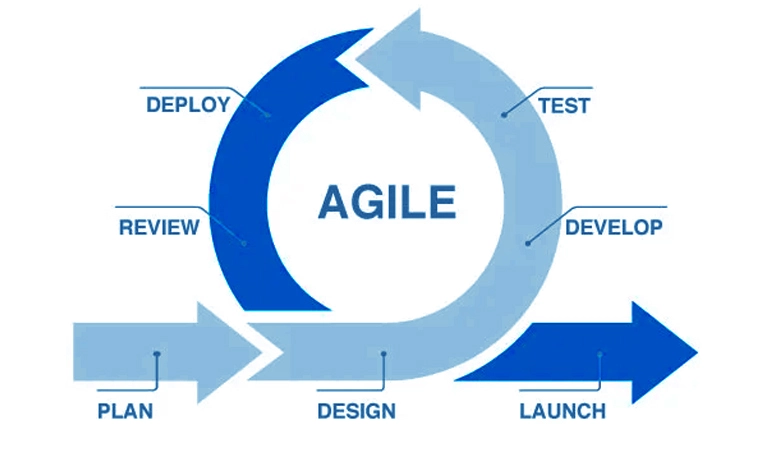

4 Core Agile Values
- People and Interactions over Processes and Instruments: Agile prioritizes the significance of individuals and their interactions in software program improvement over relying solely on processes and instruments. IT emphasizes open communication, collaboration, and teamwork amongst crew members.
- Working Software program over Complete Documentation: Agile values the supply of working software program as the first measure of progress. Whereas documentation is necessary, Agile encourages groups to give attention to delivering tangible worth to clients by way of purposeful software program.
- Buyer Collaboration over Contract Negotiation: Agile promotes shut collaboration between improvement groups and clients all through the challenge. By involving clients within the improvement course of, Agile ensures that the delivered software program meets their wants and expectations.
- Responding to Change over Following a Plan: Agile embraces change as a pure and inevitable a part of the software program improvement course of. Agile groups are inspired to adapt and reply to altering necessities, priorities, and suggestions, as a substitute of rigidly following a predefined plan.
Ideas of Agile
- Fulfill the Buyer by way of Early and Steady Supply of Worthwhile Software program: Agile prioritizes delivering working software program to clients incessantly, enabling early suggestions and guaranteeing that the delivered software program offers worth to the shopper.
- Welcome Altering Necessities, Even Late in Growth: The Agile method acknowledges that necessities are prone to change over time and encourages groups to embrace change relatively than resist IT. Subsequently, Agile rules processes are designed to accommodate altering necessities and priorities all through the challenge.
- Ship Working Software program Incessantly, with a Desire to Shorter Timescales: IT promotes iterative improvement and incremental supply, with a give attention to delivering small, usable increments of software program incessantly. Shorter improvement cycles permit for quicker suggestions and adaptation.
- Enterprise Folks and Builders Should Work Collectively Day by day All through the Undertaking: Shut collaboration between enterprise stakeholders and improvement groups is the cornerstone of the Agile SDLC. By working collectively day by day, stakeholders can present well timed suggestions, make clear necessities, and guarantee alignment between enterprise targets and technical implementation.
- Construct Tasks round Motivated People, Give Them the Atmosphere and Help They Want, and Belief Them to Get the Job Performed: The Agile methodology acknowledges the significance of motivated and empowered crew members. Groups are given the autonomy, sources, and assist they should succeed, with belief positioned of their means to ship outcomes.
- The Most Environment friendly and Efficient Technique of Conveying Information to and Inside a Growth Workforce is Face-to-Face Dialog: Agile values face-to-face communication as the best solution to convey Information and guarantee shared understanding amongst crew members. Whereas distant communication instruments will be helpful, Agile encourages direct interplay each time doable.
- Working Software program is the Main Measure of Progress: As a software program methodology, Agile emphasizes the significance of delivering working software program as the first measure of progress. IT assesses progress primarily based on the performance and worth IT delivers to clients relatively than adherence to timelines or milestones.
- Agile Processes Promote Sustainable Growth. The Sponsors, Builders, and Customers Ought to Be Capable of Keep a Fixed Tempo Indefinitely: Agile seeks to keep up a sustainable tempo of improvement over the long run. By avoiding overwork and burnout, groups can maintain their productiveness and ship high-quality software program constantly.
- Steady Consideration to Technical Excellence and Good Design Enhances Agility: Agile emphasizes the significance of technical excellence and good design practices in software program improvement. By prioritizing high quality and craftsmanship, groups can keep agility and reply successfully to altering necessities.
- Simplicity—the Artwork of Maximizing the Quantity of Work Not Performed—is Important: Agile encourages simplicity in each the software program being developed and the event course of itself. By specializing in the necessities and minimizing pointless complexity, groups can maximize productiveness and ship worth extra effectively.
- The Greatest Architectures, Necessities, and Designs Emerge from Self-Organizing Groups: The Agile method promotes self-organizing groups which can be empowered to make choices and resolve issues autonomously. By leveraging the collective experience and creativity of crew members, Agile groups can produce modern options that meet the wants of stakeholders.
- At Common Intervals, the Workforce Displays on The right way to Turn into Extra Efficient, Then Tunes and Adjusts Its Conduct Accordingly: Groups that comply with the Agile method interact in common reflection and adaptation to enhance their effectiveness. By retrospectives and steady enchancment practices, groups determine areas for enhancement and modify their processes accordingly to optimize their efficiency.
-
Scrum
Scrum is among the hottest Agile frameworks. IT is characterised by its iterative method, self-organizing groups, and emphasis on delivering worth to clients briefly cycles known as sprints. Scrum was formalized within the early Nineteen Nineties by Jeff Sutherland and Ken Schwaber. Since then, IT has turn out to be some of the extensively used Agile methodologies.
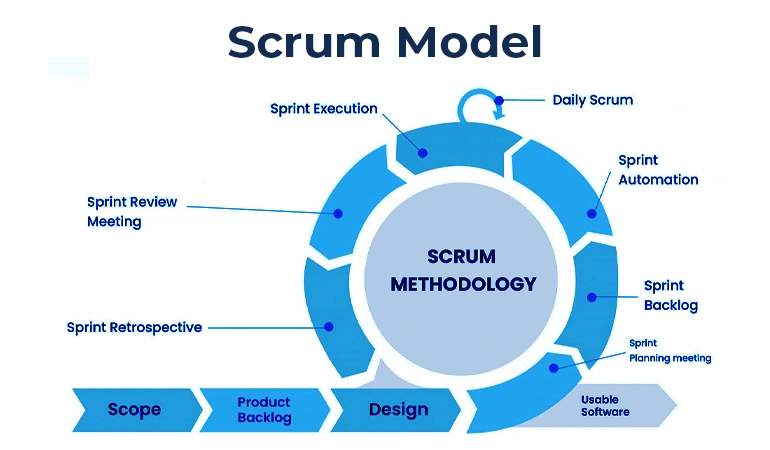

Core Elements of Scrum
Roles
- Product Proprietor: Represents the stakeholders and is answerable for defining and prioritizing the product backlog, guaranteeing that the crew delivers worth to the shopper.
- Scrum Grasp: Facilitates the Scrum course of, removes impediments, and helps the crew adhere to Scrum rules and practices.
- Growth Workforce: A cross-functional crew answerable for delivering increments of working software program throughout every dash.
Artifacts
- Product Backlog: A prioritized record of all desired options, enhancements, and fixes for the product. Managed and prioritized by the Product Proprietor.
- Dash Backlog: A subset of things from the Product Backlog chosen for implementation through the dash. IT is owned by the Growth Workforce.
- Increment: A doubtlessly shippable product increment produced by the event crew through the dash.
Occasions
- Dash Planning: It is a assembly the place the Product Proprietor and Growth Workforce collaborate to pick out and plan the work for the upcoming dash.
- Day by day Standup (Day by day Scrum): A brief, day by day assembly the place crew members synchronize their work, focus on progress, and determine any obstacles.
- Dash Evaluate: A gathering on the finish of the dash the place the crew demonstrates the finished work to stakeholders and collects suggestions.
- Dash Retrospective: A gathering held after the Dash Evaluate permits the crew to mirror on their course of. They determine what goes properly and what may very well be improved and create a plan for implementing adjustments within the subsequent dash.
-
Kanban
Kanban has its roots in a Japanese manufacturing method employed by the main vehicle producer, Toyota. IT is a visible administration technique that interprets to “visible card” or “signboard” in Japanese.
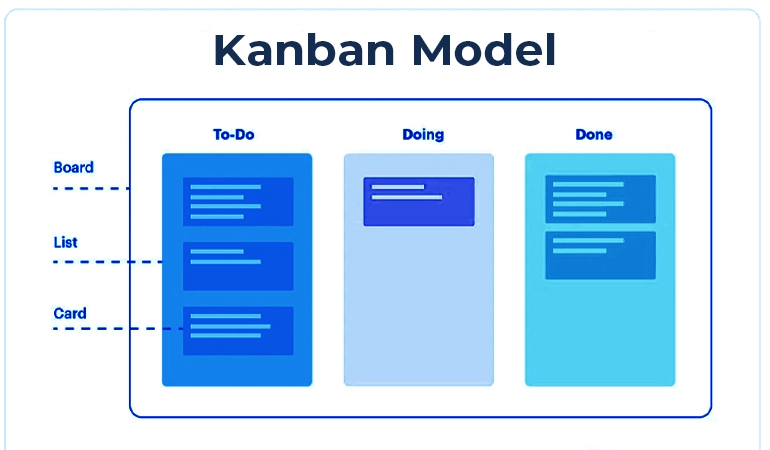

Not like another SDLC methodologies, Kanban doesn’t prescribe particular phases or iterations. As an alternative, IT focuses on steady supply, effectivity, and minimizing waste by visualizing and optimizing the movement of labor.
-
Lean
Lean Software program Growth is impressed by Lean manufacturing rules and goals to maximise worth whereas minimizing waste. IT emphasizes delivering worth to clients shortly, optimizing the entire course of, and empowering groups to repeatedly enhance.
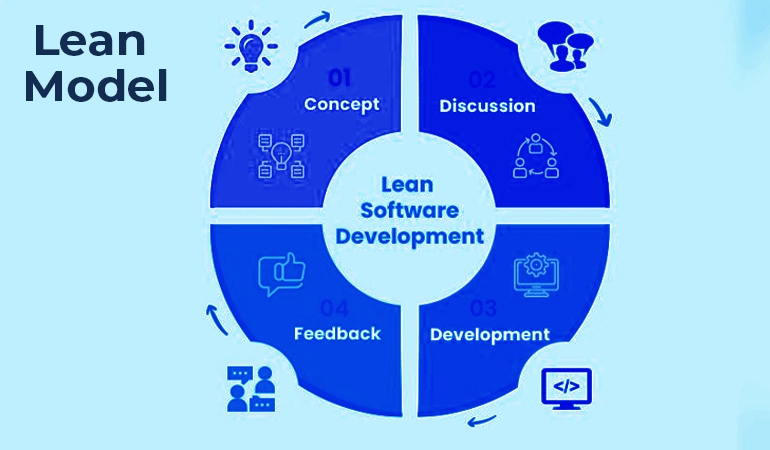

Its key rules embrace:
- Remove waste within the improvement course of, comparable to pointless options, rework, and delays.
- Amplify studying by repeatedly looking for suggestions from clients and stakeholders and utilizing IT to enhance processes and merchandise.
- Lean emphasizes delivering worth to clients shortly by way of small, incremental releases.
- Workforce empowerment is one other key precept of the Lean method. IT encourages cross-functional, self-organizing, and empowered groups to take possession of their work.
-
Excessive Programming
One other Agile framework, Excessive Programming (XP), focuses on delivering high-quality software program whereas conserving the event course of versatile. IT was created within the late Nineteen Nineties by Kent Beck and Ward Cunningham and is understood for its rigorous engineering practices and give attention to buyer satisfaction.


A few of its key practices and rules embrace the next:
- XP advocates for delivering small, frequent releases of working software program to clients, enabling early suggestions and validation of options.
- Planning in XP is steady and adaptive, with a give attention to short-term planning and responding to altering necessities and priorities.
- XP is known for its pair programming, the place builders work in pairs, with one writing code whereas the opposite opinions IT in actual time. Pair programming improves code high quality, promotes data sharing, and reduces defects.
- XP builders write automated assessments earlier than writing the code. This ensures that the code meets the specified performance and will be simply examined for regressions.
-
DevOps
The DevOps method is among the hottest software program improvement approaches right this moment. IT is a cultural and organizational motion that goals to interrupt down silos between improvement (Dev) and operations (Ops) groups. This allows a extra speedy and dependable software program supply.


IT emphasizes collaboration, automation, steady integration, steady supply (CI/CD), and monitoring all through the software program improvement lifecycle. Its large recognition is evidenced by the variety of corporations providing DevOps as a Service (DaaS).
A number of the key rules of DevOps embrace:
- DevOps emphasizes a tradition of collaboration, belief, and shared accountability between improvement, operations, and different stakeholders. IT promotes communication, empathy, and a give attention to delivering worth to clients.
- Automation is on the coronary heart of DevOps. IT advocates for automating repetitive duties, comparable to code builds, testing, deployment, and infrastructure provisioning, to extend effectivity, cut back errors, and unlock time for extra beneficial work.
- DevOps additionally doubles down on CI/CD.
- Safety is paramount for all DevOps engineers. They incorporate safety practices all through the software program improvement lifecycle, together with risk modeling, vulnerability scanning, and automatic safety testing. That is also called DevSecOps.
Conclusion
IT has been a very long time because the Waterfall method dominated software program improvement. At the moment, newer, extra nimble approaches have overtaken conventional ones. Though Agile and its related sub-approaches reign supreme right this moment, we don’t know what the longer term holds. Come tomorrow, we could count on the emergence of much more modern and environment friendly software program improvement life cycle methodologies. However for 2024, we guess that these are the highest SDLC methodologies it’s essential select from.
Are you seeking to develop high-quality software program for your small business? You’ve come to the appropriate place. Xavor is a number one IT firm with a worldwide presence and 1000+ profitable IT initiatives. We provide modern software program options to startups and Fortune 500 corporations.
Drop us a line right this moment at [email protected] to schedule a free session name with our IT companies crew.